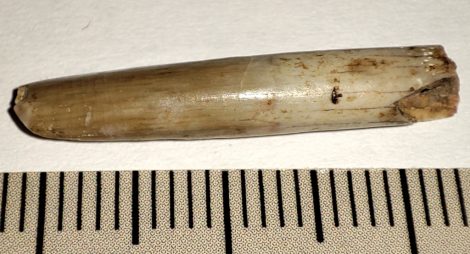- New arrivals
- Products in stock
- Mammuthus fossils [476]
- Megaloceros deer fossils [22]
- Bison Bos fossil [27]
- Rhinoceros fossil [31]
- Echinoderms sea urchin fossil [27]
- Plant wood fossils [38]
- Fish and shark fossils [52]
- Ammonites cephalopods [33]
- Mammalian vertebrates fossils [86]
- Dinosaurus fossil [54]
- Shells fossils [12]
- Gastropods fossils [30]
- Coral fossils [5]
- Trilobites & Crabs fossils [26]
- Minerals [28]
- Insect fossils [17]
- Other Fossils [14]
- Books, literature [10]
Rapetosaurus krausei tooth from Madagascar
Cretaceous period: 70-66 million years old dinosaur tooth of Rapetosaurus krausei. The origin of the dinosaur tooth is Madagascar, Mahajanga Basin. The dimensions of the tooth are about: 25.5 mm x 5 mm x 4 mm. Weight: about: 1 gram. The tooth is provided in a plastic storage box of about: 27 mm x 27 mm x 26 mm.
Rapetosaurus was a quadrupedal herbivore; it is estimated to have reached 15 meters (49 feet).
Description
Rapetosaurus was a fairly typical sauropod, with a short and slender tail, a very long neck and a huge, elephant-like body. Its head resembles the head of a diplodocid, with a long, narrow snout and nostrils on the top of its skull. It was a herbivore, with small, pencil-like teeth good for tearing leaves from trees, but not for chewing.
Its size was quite modest for a titanosaur. The juvenile specimen measured 8 metres (26 ft) from head to tail and "probably weighed about as much as an elephant". An adult would have been about twice as long (15 metres (49 ft).
Discovery and naming
The discovery of Rapetosaurus krausei, known as the only species of Rapetosaurus, was the first time a titanosaur had been found with a nearly complete skeleton and skull.
It has helped to clarify some difficult, centuries-old classification issues among this large group of sauropod dinosaurs, and provides a good starting point for reconstructing other titanosaurs known only from partially fossilized remains.
The discovery was published in 2001 in the scientific journal Nature by Kristina Curry Rogers and Catherine A. Forster. The nearly complete skeleton is that of a juvenile, and the partial remains of three other specimens have also been recovered.
The excavation yielded a partial skull (UA 8698, the holotype specimen), another partial skull, a juvenile skeleton missing only a few caudal vertebrae, and an unrelated vertebra. The juvenile skeleton is the most complete titanosaur skeleton ever found, and the only one with the head still attached to the body.
The fossilized remains were found in the Mahajanga Basin in northwestern Madagascar, not far from the port city of Mahajanga. They were recovered from a layer of sandstone known as the Anembalemba Member, which is part of the Maevarano Formation. The rock formation has been dated to the Maastrichtian stage of the Late Cretaceous period, meaning the fossilized bones are about 70 million years old.





